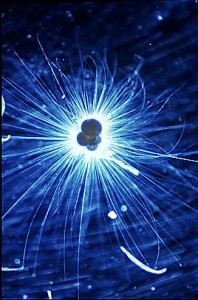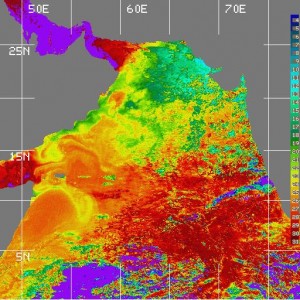NOZ – Reconstruction of Sea-surface Temperatures Using Fossil Marine Plankton #SWI2002
The predictive quality of climate models can be enhanced by incorporating information about temperatures from the past. A number of methods have been developed to determine the ancient temperatures of the upper ocean, and one of these is based on the use of deep-sea microfossils.
For many millions of years, a large number of species of the invertebrate group planktic foraminifera have lived in the upper water level of the world’s oceans. These organisms produce little shells of calcite (CaCO3) that function as a skeleton. Without changing the isotope ratio of oxygen in the dissolved CO2 in the ambient water, the water temperature has a direct influence on the isotope composition in the calcite shells of the plankton. If one would know the isotope composition of the ocean water, one could hence deduct the ocean water temperature from the isotope composition in the calcite shells. The isotope composition of the ocean water from ancient times is practically unknown, however, and, for theoretical reasons, it’s not advisable to try to model it either. One way to get around this problem is to take more than one species of plankton:
 The different species of plankton don’t prefer the same ecological conditions. Some are adapted to live under colder conditions than others. One may hence in principle infer absolute temperature differences from plankton that has lived during the same time-span in the same water level in the same region: the isotope ratio of the water remains fairly constant during relatively short time-spans, but temperatures differ considerably both regionally (see figure 1) and in time. Information could thus be obtained about both average temperatures in a given era, and of the variability of these temperatures. The variability is quite large, and therefore interesting to know. Other methods to determine ancient seawater temperatures only obtain mean temperatures, but the NIOZ is interested to obtain variances as well.
The different species of plankton don’t prefer the same ecological conditions. Some are adapted to live under colder conditions than others. One may hence in principle infer absolute temperature differences from plankton that has lived during the same time-span in the same water level in the same region: the isotope ratio of the water remains fairly constant during relatively short time-spans, but temperatures differ considerably both regionally (see figure 1) and in time. Information could thus be obtained about both average temperatures in a given era, and of the variability of these temperatures. The variability is quite large, and therefore interesting to know. Other methods to determine ancient seawater temperatures only obtain mean temperatures, but the NIOZ is interested to obtain variances as well.


